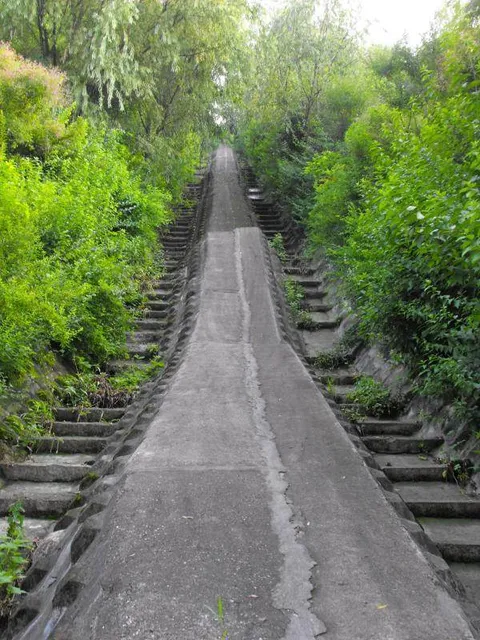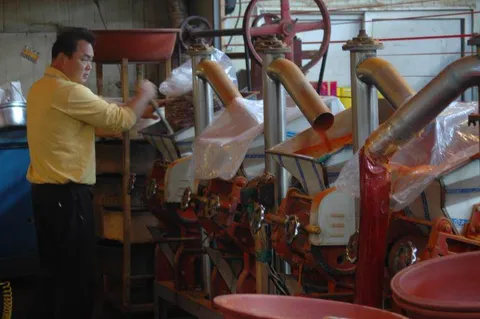
Another huge park located in Seoul, the World Cup Park offers several days’ worth of water, walking, wheels, and nature within walking distance of the subway system. More than just a green area amended to a stadium, Seoul’s World Cup Park is a testimony to an environmental dream.
According to the official World Cup Park website, the area was used as a landfill beginning in 1978 during Seoul’s rapid growth and urbanization. From 1978 to 1993, about 90 million tons of trash were dumped there, creating two massive mountains over 90 meters in height. Presumably realizing the World Cup games would be coming soon, Seoul began to transform the area into a park; today, there’s no sign of a landfill to be seen by the average park-goer. You might notice some of the signs regarding the area’s past or a note on how methane gas is collected and recycled, but there’s nothing to see or smell otherwise.

One of several areas where rollerblading is popular, whether the signs always allow it or not.
Starting from the World Cup Stadium, which is itself an entirely separate tourist attraction, walk straight out the exit along the road, crossing the road and eventually entering Pyeonghwa Park (446,000 square meters). This is one of the five named parks in the area; the others include Haneul Park (192,000 square meters), Noeul Park (340,000 square meters), Nanjicheon (294,000 square meters), and Hangang Riverside Park (AKA the Nanji Area – the largest at 777,000 square meters).

A huge fountain in Pyeonghwa Park, near the boardwalk that makes up a nice part of the park.

Boardwalk and green – it may not be Wolmi-do, but the boardwalk has just as much activity along it.

Some wooden faces to greet you near a souvenir / convenience store.

 A nice park for the kids or the wish-they-were-still-kids.
A nice park for the kids or the wish-they-were-still-kids.

Beautiful – need I say more?

A nice archway breaking things up – and providing some shade.

As mentioned earlier, the park and area is quite popular with skaters and bladers of a casual nature. Serious rollerbladers could also be seen on some of the smoother concrete across the park

A little stream to walk in, or just walk by. The signs not to cross the rope were largely ignored by the crowd; since the stream was no more than calf-deep, the biggest danger was stepping on a sharp rock.

Part of another tunnel of sorts, this one had gourds growing on it!

Water shoots from the ground to the enjoyment of quite a few kids sitting or playing.

Nearing the end of Pyeonghwa Park – what have we here? Some modern art of sorts?

Nope – solar panels designed to create energy – not pictured was nearby sign showing the current energy generation and cumulative energy generation.

A perfectly formed row of trees – nice.

The stairs leading up to Haneul Park – at this point we had been exploring for several hours, so the stairs were out. Instead, we walked around the park via a walking trail. With plenty of trees and nature, you could almost forget that you’re still in Seoul – almost. The sounds of traffic were still enough to remind you of the 10,000,000 other people in the city.

Fenced off from the trail, a place for rainwater to run off? Not sure, but with a two-meter fence guarding it, we weren’t about to jump it.

Across the street from the World Cup Stadium was a large market. Plenty of fish, vegetables, and fruits for the locals or curious tourists courageous enough to meander in.

Grinding red peppers to make gochujang, or red pepper paste.

It’s not just garlic, it’s almost artsy.

A jangseung, or Korean totem pole intended to scare away evil spirits. There’s quite a few in the first section of the World Cup Park in front of a convenience store.

Wide open spaces with plenty of room to move around, or just take a picnic if the weather were warmer.

A walk up several zig-zags worth of stairs to reach Hanuel Park – the grass park built on top of a landfill. Although it’s quite large – 192,000 square meters – a majority is dedicated to the grasses that grow here. The Eulalia and Cogongrass grow on the northern side of the park, while sunflowers and buckwheat grow on the southern side.

The view looking down at the rest of World Cup Park – Pyeonghwa Park to be specific. That the view is spoiled by the smog can’t be helped.

After walking up the stairs and to the right, you’ll eventually see a monument welcoming you to Haneul Park.

The main dirt paths are wide enough for the crowds, although there are a few that cut into and around the grassy areas as well:


While one of the more spread-out places in Seoul, it definitely earns the ‘environmentally friendly’ award, as well as a great reuse of land. There’s not as much to see up there, and I wish signs displayed more English to help people realize the accomplishment. In the end, the entire area is worth exploring, but give it a full day or more. Don’t forget your good walking shoes!
World Cup Park is not only huge, but quite spread out. Even after several kilometers of walking, we had just scratched the surface of this area. Wear your comfortable but water-friendly shoes, and enjoy the scenery.
Directions to World Cup Park: take line 6 of the Seoul subway system to the World Cup Stadium. Take exit 1 to street level and walk along the road until you see a park to your right. That will be Pyeonghwa Park – Haneul Park and Noeul Park are further on, while the Nanji area is the Han River area. Admission is free; most areas are wheelchair / stroller accessible.


